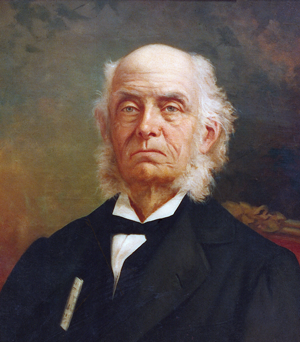 Rudolph Amandus Philippi was born in Berlin-Charlottenburg, Germany, on 14th September 1808. His mother, Maria Anna Krummwiede, worried delivering a good education at an early age sent him with his brother to Yverdon, Switzerland, in the establishment of the renowned Swiss philosopher and educator Pestalozzi. Later, Philippi acquired the degree of Doctor of Medicine at the University of Berlin. His doctoral thesis was on Orthoptera berolinensia (Diptera) in 1830. During the visit to Southern Italy 1831-1833, he made important scientific works on geology, mollusks and brachiopods in the Mediterranean and southern Italy. Back in Germany in 1835, he became a position of professor and researcher at the Polytechnic Institute in Kassel. He married Fredericka Luisa Karolina Krummwiede on 1st January 1836. Following health problems (tuberculosis), he returned to Italy from 1837 to 1839, with his wife to Naples, where their eldest son Federico (Friedrich) was born; this later (1838-1910) was a famous Chilian botanist.
Europe was going through a time of political and social unrest. Disappointed by the failure of the revolution of 1848, and persecuted because of his republican and liberal ideals, Philippi becomes convinced to emigrate in 1850 in the New World. He arrived in December 1851 in Valdivia, Chile, where he was hired as professor of German. In 1853, he becomes the position of director of the Museo Nacional de Historia natural in Santiago, as well as professor of botany and zoology at the University. Already installed, his family moved in 1854 with his library and scientific collections. Philippi devoted his long life to scientific research, with great rigor. His contribution was fundamental in the development of the scientific research in Chile, covered a wide range of natural sciences. Philippi described about 1,600 valid species, among them about 6 % of the recognized biological diversity for Chile; his greatest contributions in Chile were done in vascular plants (see references below). About 450 scientific papers were published, in several languages. He spoke a perfect English, French, German, Italian, Greek, Latin and Spanish. Asking and answering himself, on the following question: "¿Que es lo que hace Philippi? Caza moscas, las observa a través de una gruesa lente, y las dibuja en un papel. Así de extraño resulta el modo en que algunos se ganan el pan de cada día " (What's doing Philippi? Hunting flies, looking them through a thick lens, and drawing on paper. So what is strange is the way for some to earn their daily bread). R. A. Philippi passed away on 23th July 1904 in Santiago (Chile).
References
Barros Arana D., 1904. El Doctor Rodolfo Amando Philippi su visa i sus obras. Cervantes, Santiago, 244 p.
Castro S. A., Camousseight A., Muñoz-Schick M. & F. M. Jaksic, 2006. Rodulfo Amando Philippi, el naturalista de mayor aporte al conocimiento taxonómico de la diversidad biológica de Chile. Revista Chilena de Historia Natural, Santiago, 79, 133-143.
Eyzaguirre-Philippi M. T., 2008. Homenaje: Rodulfo Amando Philippi (1808-1904) - Explorador de nuestra biodiversidad. Gayana Botánica, Concepción, 65 (2), VII-XI.
Follmann G. 1970. Rudolph Amandus Philippi (1808-1904). Philippia, Kassel, 1 (1), 3-8.
Gotschlich B., 1904. Biografía del Dr. Rodulfo Amando Philippi, 1808-1904. Lampert, Valdivia, 185 p.
Horacio Larraín B., 1994. Aportes de Rodulfo Amando Philippi al conocimiento del ethos y cultura de las etnias indígenas del norte de chile. Homenaje al cumplirse los 90 años de su muerte. Revista de Ciencias Sociales, Santiago, 4, 3-18.
Reiche K., 1905. Rudolf Amandus Philippi. Berichte der Deutschen Botanischen Gesellschaft, Berlin, 22 (11), 68-83.
Schrader E., 2004. Rudolph Amandus Philippi 1808-1904, Leben und Werk. Philippia, Kassel, 11 (4), 321-334.
Some publications dealing with Mediteranean marine fauna
Philippi R. A., 1836. Enumeratio molluscorum Siciliae cum viventium tum in tellure tertiaria fossilium quae in itinere suo observavit. [Volumen secundum continens addenda et emendanda, nec non comparationem faunae recentis Siciliae cum faunis aliarum terrarum et com fauna periodi tertiariae]. Anton, Halis saxorum [Halle], vol. 1, 268 p., 12 pl.
Philippi R. A., 1844. Enumeratio molluscorum Siciliae cum viventium tum in tellure tertiaria fossilium quae in itinere suo observavit. Anton, Halis saxorum [Halle], vol. 2, 303 p., 18 pl.
Philippi R. A., 1845-1851. Abbildungen und Beschreibungen neuer oder wenig gekannter Conchylien, unter Mithülfe mehrerer deutscher Conchyliologen. Fischer, Kassel, 306 p.
Philippi R. A., 1853. Handbuch der Conchyliologie und Malacozoologie. Anton, Halle, 548 p. [Brachiopoda: p. 382-391]
Philippi R. A., 1902. Sicilien und Süd-Calabrien. In dem Jahrzehnt von 1830—1839. Abhandlungen und Bericht des Vereins für Naturkunde
zu Kassel über das 66. Vereinsjahr 1901-1902, 47, 1-49.
Nota: for a complete list of Philippi's publications, see Barros Arana (1904), Gotschlich (1904), Follmann (1970).
Links
Nordhessische Gesellschaft für Naturkunde und Naturwissenschaften (NGNN) wurde 1836 als "Verein für Naturkunde in Cassel" gegründet und erhielt 1980 den Namen "Philippi-Gesellschaft zur Förderung der Naturwissenschaften". Durch Verschmelzung mit dem "Naturschutzring Nordhessen" wurde August 2005 die "Nordhessische Gesellschaft für Naturkunde und Naturwissenschaften" Rechtsnachfolgerin.
Philippia Abhandlungen und Berichte aus dem Naturkundemuseum im Ottoneum zu Kassel: a scientific journal Philippia named in honor of R. A. Philippi
Memoria chilena
Biblioteca Fundamentos de la Construcción de Chile
Fundacion R.A. Philippi de Estudios naturales
Wikipedia.en - Wikipedia.fr - Wikipedia.es
Our best thanks to Maria Teresa Eyzaguirre-Philippi Fundacion R.A. Philippi de Estudios naturales for the permission to publish both photos.
Maria Teresa (1952) es la hija de Jaime Miguel Eyzaguirre Gutiérrez (1908-1968), abogado e historiador chileno, el principal representante de la corriente historiográfica católica en su país. Su madre Adriana Paulina Philippi Izquierdo es descendiente directo de Rodulfo Amando Philippi (vease su genealogía).
The collection de R. A. Philippi is housed in the Museo Nacional de Historia natural, Santiago (Chile)
|
|
